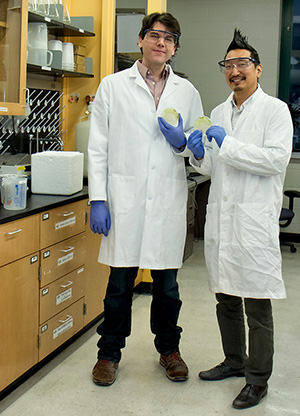Recent Headlines

Christopher Nomura and Benjamin Lundgren
Synthetic Protein Could Be Key in Battle against Disease
A synthetic protein that disrupts the ability of bacteria to perform basic life functions – moving, eating, attaching to hosts – could be a key to fighting infectious disease and preventing bacteria from evolving into drug-resistant pathogens.
A recent publication in the journal "Scientific Reports" details how a group of scientists at universities in Syracuse, New York, and Ottawa, Ontario, used a protein produced in the laboratory to muddle a bacterium's ability to regulate when certain genes are turned on, or "expressed" to use the scientists' term. Those genes allow bacteria to do things they need to do to stay alive, such as use whip-like appendages called flagella to move to a hospitable location, consume the protein that sustains them and produce the biofilms that allow them to stick together and cling to a host. Some genes allow bacteria to avoid death by antibiotics by pumping the compounds back outside of the cell.
The lead author on the paper is Dr. Megan G. Lloyd of the Department of Microbiology and Immunology at SUNY Upstate Medical University. Also contributing to the study were Dr. Benjamin R. Lundgren, a post-doctoral researcher at the College of Environmental Science and Forestry (ESF) and Dr. Christopher Nomura, a professor of chemistry and vice president for research at ESF; Jennifer F. Moffat of SUNY Upstate; and Clayton W. Hall, Luke B.-P. Gagnon and Thien-Fah Mah of the Department of Biochemistry, Microbiology, and Immunology at the University of Ottawa.
The experiments involved a strain of bacteria called Pseudomonas aeruginosa, an opportunistic pathogen found worldwide. It infects cystic fibrosis patients and people with compromised immune systems, and causes disease in soft tissues and burns.
The authors stated that the bacteria is naturally resistant to many antibiotics, including certain penicillins and cephalosporins, and easily acquires resistance through mutations or acquisition of genes. It has been identified on a recently released World Health Organization "Global Priority List" as a critical pathogen and top priority for research and development of new antibiotics. In addition, the U.S. Center for Disease Control and Prevention has reported that increased antibiotic resistance in the bacteria limits effective treatments in hospital-acquired infections, highlighting the need for novel antimicrobials.
"Preventing the expression or activity of virulence factors has emerged as a promising approach to identify and develop novel agents that would impair the ability ofP. aeruginosato cause disease," the scientists wrote.
"We've shown that there's a mechanism through which we can slow the progress of bacteria in causing disease," Nomura said. "And it could potentially inhibit the mechanism that creates resistance to antibiotics, which is obviously a huge concern."
The finding has great potential to benefit the medical field, although Nomura stressed the discovery is not a medical treatment – at least, not yet. The reaction can be obtained only in a lab, where scientists have the ability to control the way the protein attaches to the DNA sequence of a bacterium.
"This synthetic peptide can be turned on at various times in the growth of bacteria," Nomura said. "But right now, it still has to be done in a laboratory, where we can control its expression. There's no way yet to deliver it, for instance, to a bacterial infection that might be making someone sick."
Although the researchers studied the protein's affect on only one species of bacteria, the findings would likely apply to other pathogenic bacteria. "With the spread of antibiotic resistance increasing, it is important to have as many tools as possible to address the issue. The development of this synthetic peptide will help with this process," said Nomura.